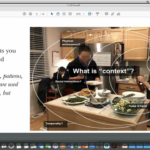
MARIA CURY*
ReD Associates
ERYN WHITWORTH*
Facebook Reality Labs
*Lead co-authors[s2If is_user_logged_in()]DOWNLOAD PDF
[/s2If]
[s2If current_user_can(access_s2member_level1)]
[/s2If]
The not-too-distant future may bring more ubiquitous personal computing technologies seamlessly integrated into people's lives, with the potential to augment reality and support human cognition. For such technology to be truly assistive to people, it must be context-aware. Human experience of context is complex, and so the early development of this technology benefits from a collaborative and interdisciplinary approach to research — what the authors call “hybrid methodology” — that combines (and challenges) the frameworks, approaches, and methods of machine learning, cognitive science, and anthropology. Hybrid methodology suggests new value ethnography can offer, but also new ways ethnographers should adapt their methodologies, deliverables, and ways of collaborating for impact in this space. This paper outlines a few of the data collection...

